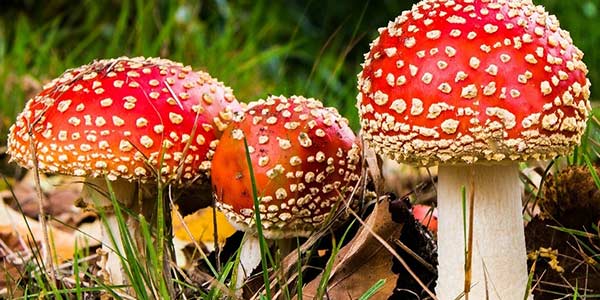 Many dogs are sickened and killed each year after eating poisonous mushrooms.
Many dogs are sickened and killed each year after eating poisonous mushrooms.
Depending on the type of mushroom and the size of your dog, it may not take much to cause some serious harm. Eating just one or two mushrooms could be a problem.
You could start seeing the signs of mushroom toxicity in as little as 15 minutes, but it can be delayed for 6–12 hours after your dog has eaten a toxic mushroom. It is very much dependent on the type of mushroom.
However, with Nephrotoxic mushrooms, signs can be delayed as long as 3 to 8 days or longer, but damage to the body is still happening. This is not typical for other types of mushroom toxicities, where symptoms usually happen sooner.
Skip to:
Symptoms of Mushroom Toxicity in Dogs
Depending on the type of mushroom, how much, and the length of time since your dog ate it, the signs of toxicity will vary.
Some common signs might include any of the following:
- Weakness
- Wobbling, loss of balance, or walking as if drunk (ataxia)
- Vomiting
- Salivating
- Dehydration
- Yellowing of skin and whites of eyes
- Sleep-like coma
- Tremors
- Vocalization
- Agitation
- Seizures
If these or other concerning signs are noted, or if you know your dog has eaten mushrooms, please contact your veterinarian, animal poison control, or an Animal ER immediately. Poisonous mushrooms attack the liver, and the liver is too important of an organ to lose.
The sooner you bring your pup in; the sooner treatment can begin. Delaying treatment can result in more extensive organ damage, requiring more advanced and expensive treatments, which, as Brutus' case (see story below) highlights, still may not be enough.
Mushroom Toxicity Can Happen Quickly
You may remember reading about actor and dog lover Dwayne “The Rock” Johnson, losing his beloved French Bulldog, Brutus, due to mushroom poisoning — mushrooms that were growing in his own yard. So sad!
View this post on InstagramA post shared by therock (@therock) on
We are sharing his story to highlight that this is a very serious toxicity. If someone with the financial resources of The Rock couldn't save their dog from liver failure, it demonstrates how important prevention is.
Don't Wait! Clear Out All Mushrooms in Your Yard
The problem with mushrooms is that they can grow very quickly, and they can be hard to completely remove from your yard. Add to this a dog's strong curiosity and keen sense of smell and the fact that many people can't easily tell which mushrooms are safe if ingested, and you've got a recipe for disaster.
Most Common and Dangerous Mushrooms for Dogs
The first thing is to know what mushrooms are toxic and which aren't. Some of the most common are in the Amanita family, like the aptly-named “Death Cap” mushroom — which, because of their "fishy" odor and taste, are often very attractive to dogs. Ingestion of even a small amount of some Amanita mushrooms can severely sicken or kill a dog because of the devastating effect they can have on the liver.
If you're not sure if a mushroom is toxic or not, it's safest to remove them completely, especially if your dog has easy and unsupervised access to the areas where they grow. Read our tips further down for what you can do to remove or lessen mushroom and fungus growth in your yard.
These photos are just a few examples of mushrooms from the Amanita family. But there are a few other very dangerous types of mushrooms, too. We have more tips and resources on mushroom identification at the end of this article.
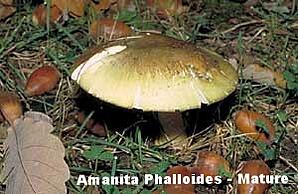
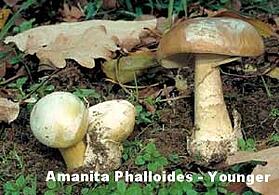
Photos source: the Australian National Botanic Gardens
This photo (below) was taken by one of our Preventive Vet colleagues on a walk with their dog. These are likely Amanita Muscaria mushrooms, which are also highly toxic to dogs.
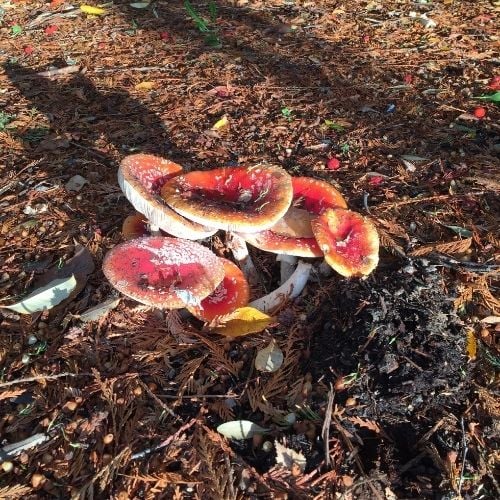
How to Tell if a Mushroom is Toxic for Your Dog
Poisonous snakes have different characteristics from non-poisonous snakes to help people tell them apart. The good news so does mushrooms! Since there are over 14,000 species of mushrooms, many of which are safe and edible, knowing what characteristics help identify if they are toxic or not is very beneficial to pet owners.
Just like for everything else, there is an app. Find a mushroom identifier app that coincides with the mushrooms in the areas where you live and visit. There are a few apps listed below in the additional resources sections.
A quick reference to help identify those mushrooms that are edible and those that are not
When you encounter a mushroom, examine it to see if it has the following poisonous characteristics:
- Unpleasant, harsh, or caustic smell
- Can have ‘scales’ and/or raised lumps
- White gills on the underside of the mushroom
- Red in color, either the cap or stem
- A ring(s) around the stem
- The stem is bulging at the base
If any of these characteristics are present, assume the mushroom is toxic. When in doubt, air on the side of caution by assuming they are toxic and take your dog to the vet if your pup has eaten some.
What to Do to Help Control Mushrooms in Your Yard
Sadly, getting rid of mushrooms is a temporary fix, at best, since they are just the above-ground evidence of beneficial fungal growth in your yard. However, the faster you remove them; hopefully, it will prevent more spores from being spread to produce more fungi.
NOTE: Applying fungicide treatments to the areas where mushrooms are present doesn’t address the issue that actually causes mushrooms to grow, nor does it kill the mushrooms.
How to Slow the Growth and Spread of Mushrooms
Lawn Care
- Damp conditions are what encourage fungi and mold growth. Reduce the frequency you water your yard. Typically for healthy and well-rooted yards, watering every week or two is adequate. Watering more often will encourage more fungus growth.
- Improve water penetration and air movement by aerating the soil and removing excess thatch.
- Keep grass trimmed short and rake up all grass clippings.
- Based on your lawn type, apply nitrogen fertilizer (don’t use the slow-release type). This will help speed up the decomposition of grass and leaf clippings. By doing this, you help prevent the fungus from getting started.
- I prefer liquid fertilizers, as they tend to be easier to apply, and typically once dry, they are safe for people and pets.
- An example of a dry solution would be ammonium sulfate in a ratio of 5 pounds per 1000 sq. ft.
- I prefer liquid fertilizers, as they tend to be easier to apply, and typically once dry, they are safe for people and pets.
Yard Maintenance
- Remove old mulch that contains decaying organic material that encourages the growth of mushrooms.
- Perform some targeted pruning and trimming of trees to decrease shady areas on your lawn. This extra sunlight will help decrease moisture in the lawn.
Pet-Safe DIY Mushroom Killer
- When you do pluck a mushroom, be sure to place it in a bag that you can tie off. This way, the spores cannot travel to other areas of your yard.
- Pet-Safe Mushroom Killer Recipe: Mix 1 part vinegar to 4 parts water. Use a spray bottle to apply this to the surface of mushrooms. Note: These will not kill mushrooms below the surface — only the parts above ground will die off, but the fungus in your lawn will continue to produce mushrooms. Another option is 1 tablespoon of baking soda to a gallon of water. Pour over the mushrooms so it soaks into the soil. This helps, with significant use, to make the soil pH neutral, which may result in fewer mushrooms.
- If you are trying to remove mushrooms naturally, it can take some time, so your dog shouldn't have access to the area where they are growing.
What to Do if You Suspect Toxic Mushrooms in Your Yard
If you see mushrooms in your yard, carefully remove one or two and bring them for identification to a local garden store or a local mushroom (mycology) expert. Alternatively, you can take pictures of the mushrooms for identification (just make sure you photograph all of the identifying parts – the gills, the cap, the base of the stem, etc.).
Because mushroom growths can be difficult to fully get rid of, it’s best to consult with an expert on ways to deal with them in your yard. And if the mushrooms in question are confirmed to be toxic to dogs, be sure to keep your dogs out of the yard (or at least that part of the yard) until the mushrooms are removed or sectioned off.
If you have mushrooms in your yard, take a look at the articles and resources below. They can better help you identify and react to those little fungi popping up all over the place. And hopefully, they will help you, and your pup better enjoy your walks together and romps in the yard.
How to Protect Your Dog from Toxic Mushrooms on Walks and Hikes
While out walking or hiking with your pup, it can be difficult to see mushrooms and guide your dog away before they sneak in a bite or two. The easiest way to help prevent ingestion of mushrooms is to keep your dog on a leash and carefully check the areas they are wanting to go sniff and explore. While hiking, you can allow your dog more freedom to roam by having them on a long leash.
- Encourage lots of check-ins using their name recognition cue to stay connected and aware while on your adventure.
- Teaching your dog to "drop it" is especially helpful if you see them munching on something, along with a solid "leave it" cue to prevent them from grabbing something off the ground.
- Carry a mushroom identification book or download a smartphone app.
- If your dog has a habit of eating things off the ground, you can teach them how to wear a basket muzzle or an OutFox Field Guard. If you decide to use a muzzle, you'll need to choose one that allows for panting and drinking, but has a guard at the front to prevent ingestion of items like mushrooms.
The Baskerville Ultra muzzle is popular, but your dog may still be able to finagle a mushroom through the front openings if they are determined. A great option for dogs who love to "grab and eat" while out and about is the BUMAS muzzle, which is made to order for a perfect fit and designed with less open access at the front of the muzzle to prevent foraging.
If you suspect your dog has eaten a toxic mushroom, abandon your hike, as time is of the essence in getting your dog evaluated. Try to grab a sample of the mushroom to bring to your vet, or take several photos of the cap and stems. Contact a pet poison hotline or a veterinarian for their advice on next steps.
It's always a good idea to carry a pet first-aid kit with you that contains pet-safe hydrogen peroxide. If you call a veterinarian and they inform you to make your dog vomit while you're still out on the trail – in case you're hours away from a veterinary hospital – this will come in handy.
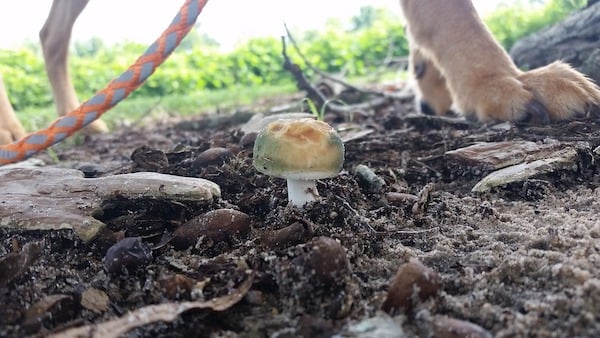
If you're worried that your pet may have eaten a poisonous mushroom, get samples and good pictures of the mushroom(s) and then contact your veterinarian, Animal ER, or a pet poison hotline immediately! More emergency resources are linked below, including a few free resources.
Additional Toxic Mushroom Resources:
- Free Service: State-by-state list of mushroom experts who can help you with mushroom identification in poisoning cases
- Free Emergency Resource: Poisons Help; Emergency Identification For Mushrooms & Plants. This open Facebook group can be a great resource in the event of an unknown mushroom or plant ingestion by your cat or dog. The admins are skilled at mushroom & plant ID and typically respond quickly. Be sure to have good photos of the offending plant or mushroom from all angles and in good light, as these will be crucial to help ensure the best chance of an ID. This resource does not replace medical evaluation by a veterinarian but can ease your mind.
- “Death Cap” (Amanita phalloides) and other poisonous Amanita mushrooms
- General information on identifying Amanita mushrooms
- General identification of poisonous mushrooms
- Mushroom poisoning in cats and dogs
- The Best Apps for Mushroom Identification and Why a Book is Better
- Phone App – Apple Store: Mushroom Identification
- Phone App - Apple Store: Shroomify Mushroom ID
- Phone App – Google Play: Mushroom Identify
- Book: Mushrooms of the Pacific Northwest
- Book: All That the Rain Promises and More: A Hip Pocket Guide to Western Mushrooms




